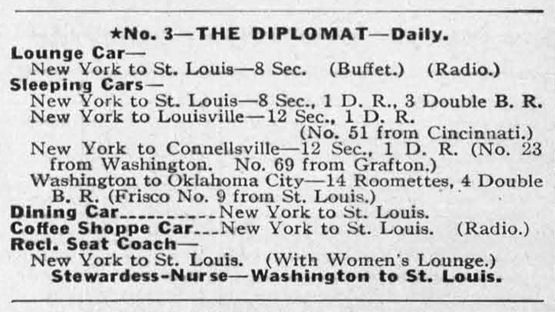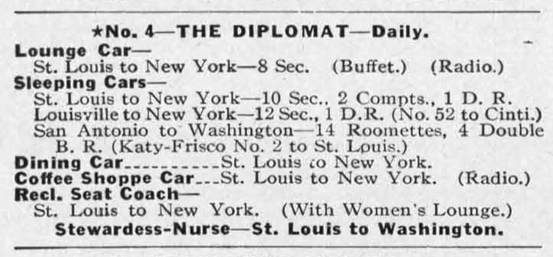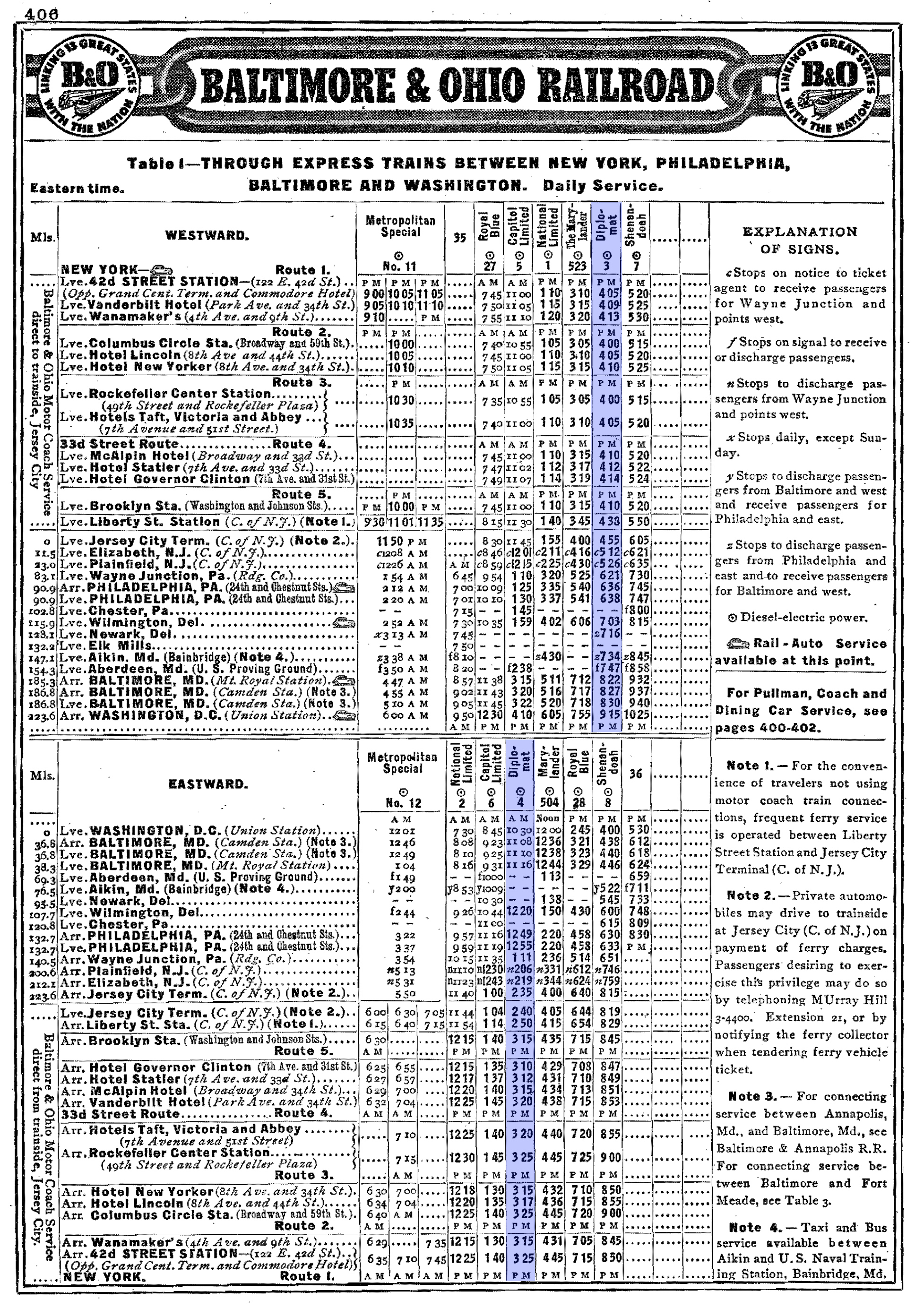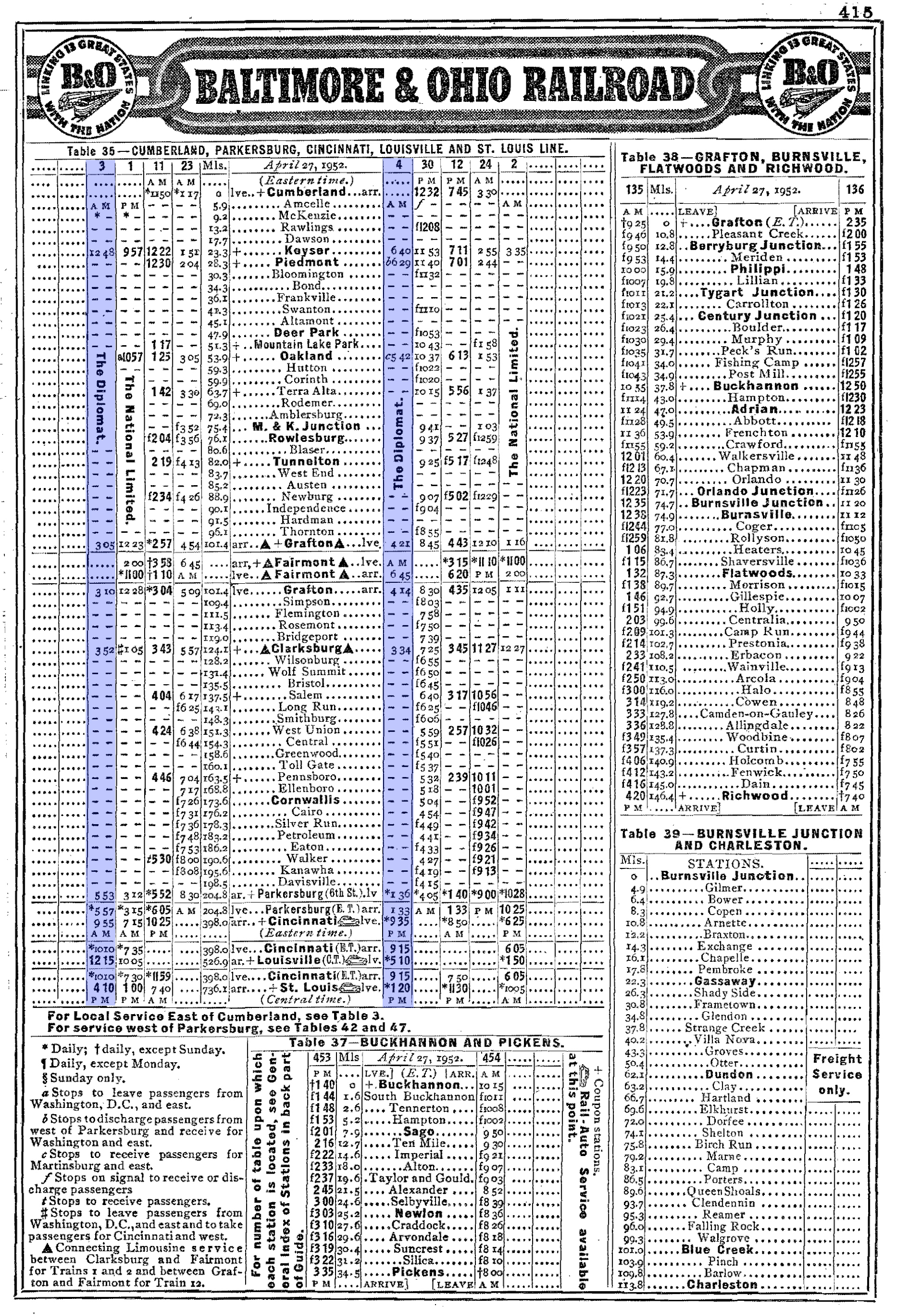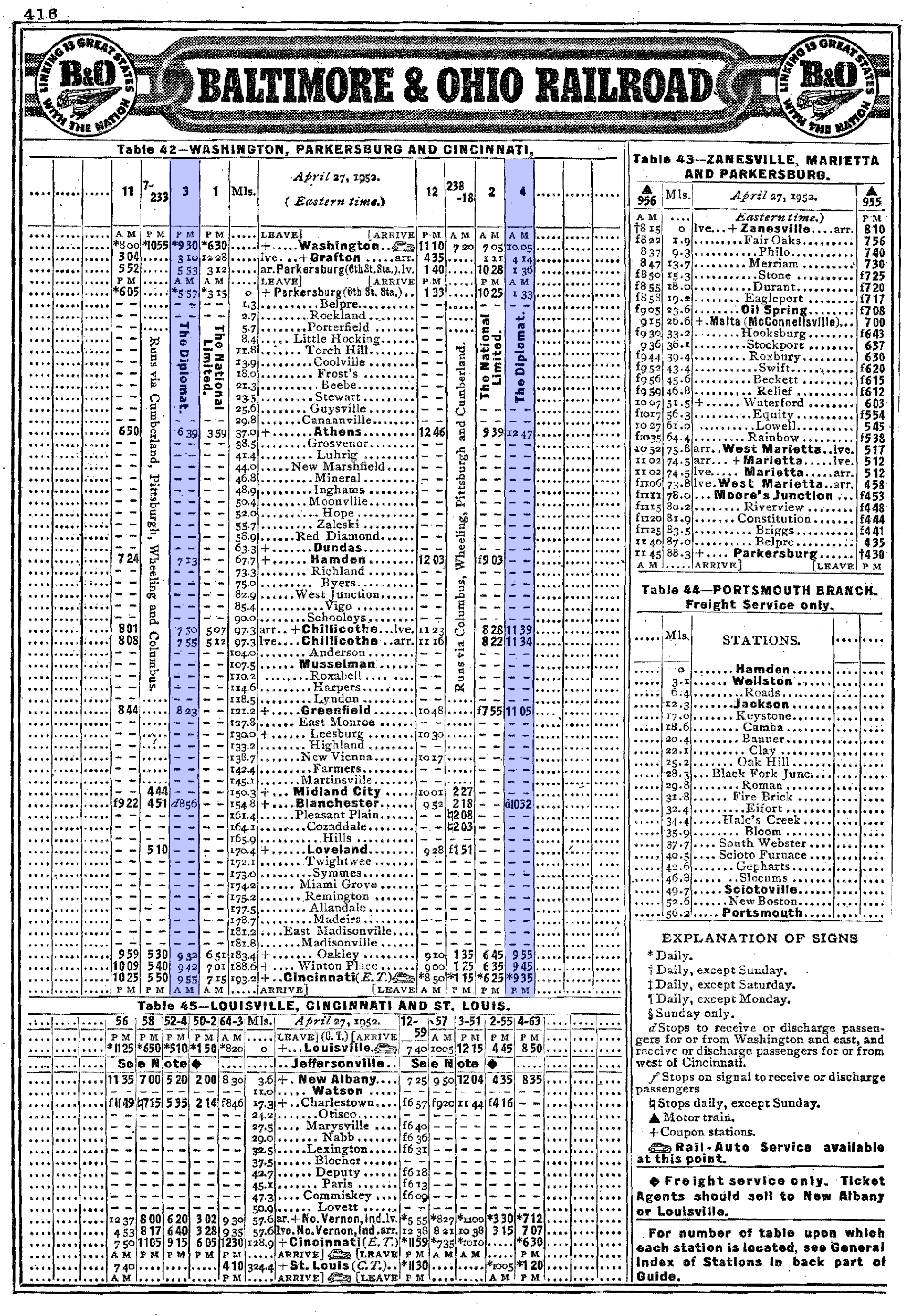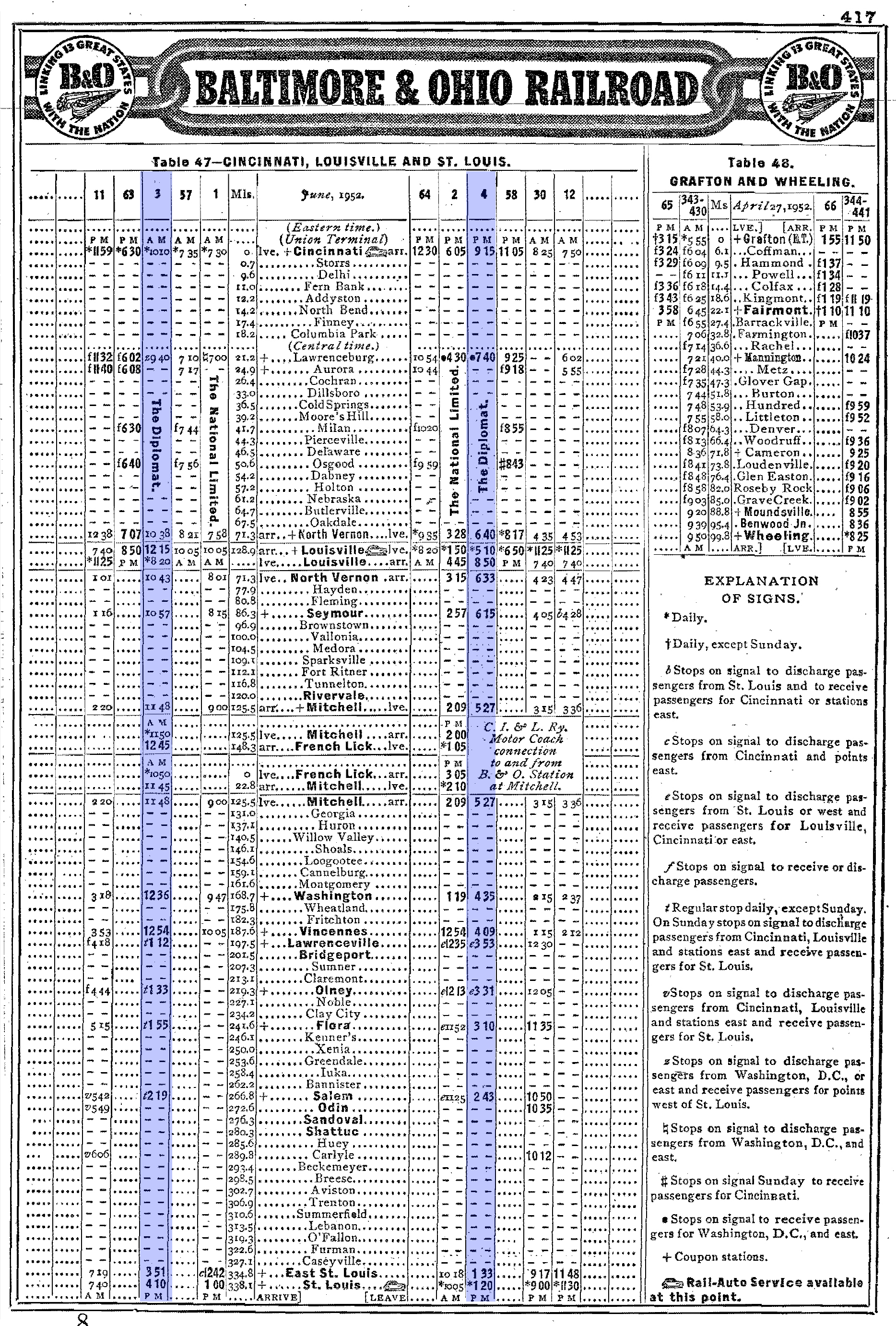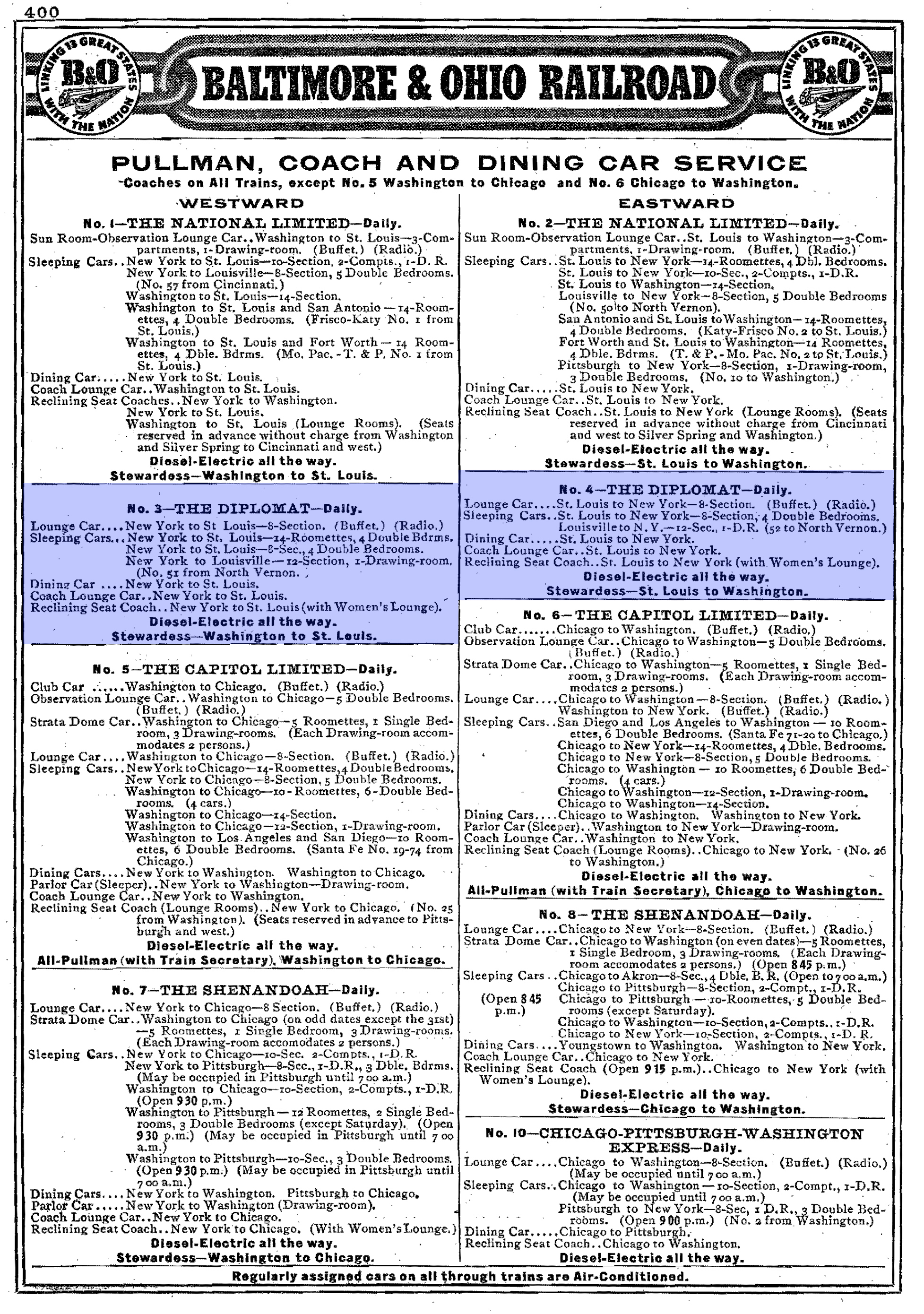B&O's "Diplomat" (Train): Consist, Timetable, Photos
Last revised: February 27, 2025
By: Adam Burns
Baltimore & Ohio's Diplomat served its Washington, D.C./Baltimore-St. Louis, a secondary run behind the posh National Limited.
The train began as the renaming of another B&O consist during the Great Depression and while it never received the National's prominence it was nevertheless popular for many years thanks to its fast scheduling and Pullman accommodations.
History
Due its second-tier status the Diplomat was one of the B&O's earliest trains to feel the pinch of cutbacks during the 1950s.
The railroad did its best in an attempt to keep up patronage on the train but to little avail. In the end, with the company's financial status very weak and needing to reduce costs the B&O canceled the train during the early 1960s.
Photos
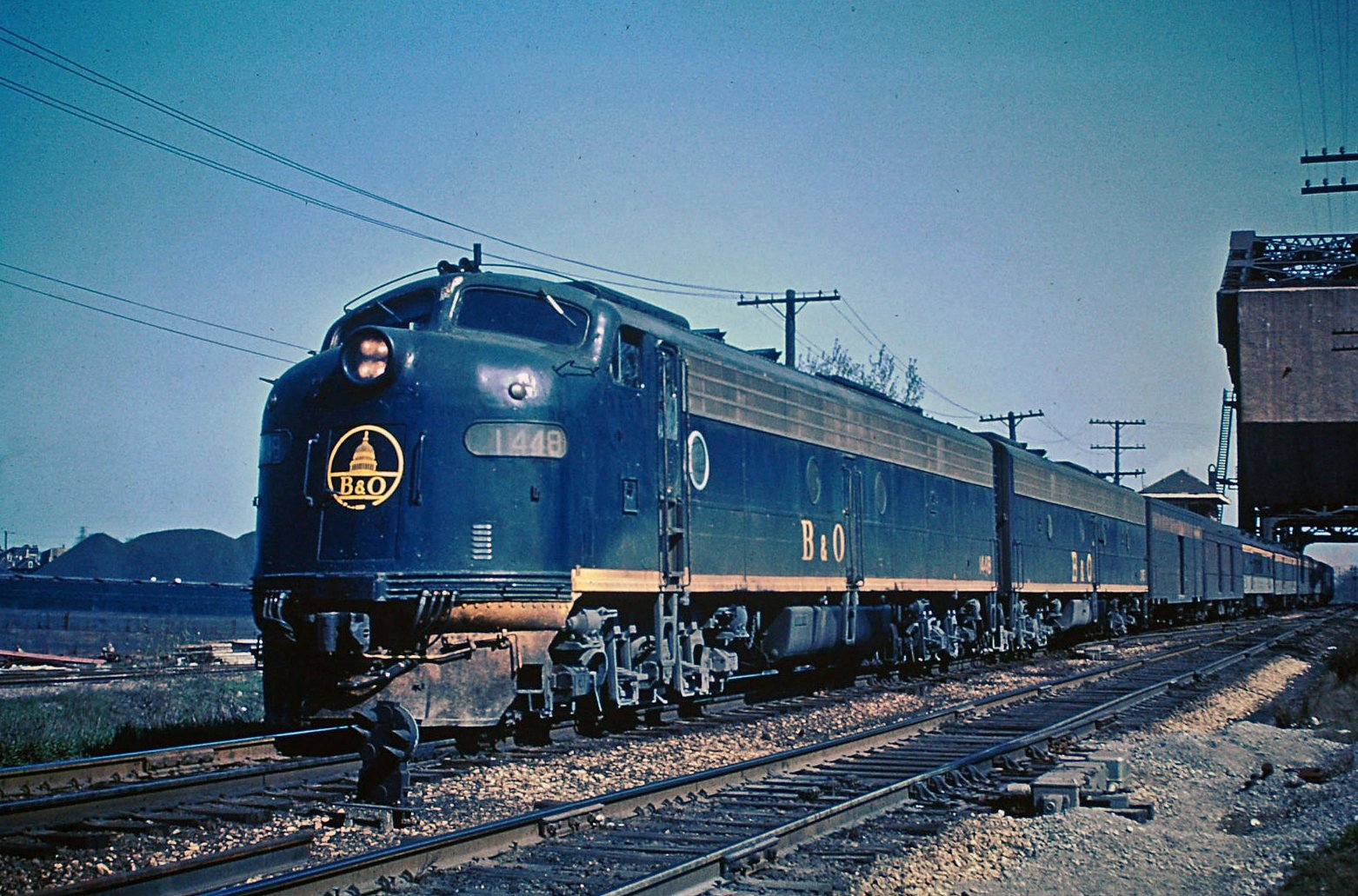 Baltimore & Ohio E8A #1448 leads the "Diplomat" (Washington - Chicago) through South Chicago, Illinois in May, 1967. By the date of this photo the train provided only reclining seat coaches and a food bar coach.
Baltimore & Ohio E8A #1448 leads the "Diplomat" (Washington - Chicago) through South Chicago, Illinois in May, 1967. By the date of this photo the train provided only reclining seat coaches and a food bar coach.When Union Pacific and Chicago, Burlington & Quincy introduced the streamliner concept in 1934 the B&O was one of the first to embrace it. Despite the company's financial struggles due to the ongoing economic downturn it was able to purchase two streamlined trainsets in 1935, one consisting of aluminum and the other of Cor-Ten steel.
These beautiful cars were manufactured by American Car & Foundry and acquired through the assistance of a U.S. Reconstruction Finance Corporation loan. The aluminum set was assigned to the Royal Blue while steel acquires were sent west to operate on the new Abraham Lincoln.
In 1938 the B&O continued its streamlining efforts by completely overhauling its flagship service, the Capitol Limited (serving New York - Chicago), with rebuilt heavyweight cars.
The railroad was also the first - along with the Santa Fe - to utilize the first streamlined diesel; Electro-Motive's EA (and E1). In 1940 the B&O continued its streamlining efforts by upgrading the National Limited , its top service between New York-Washington/Baltimore-St. Louis.
Prior to the National's streamlining it had received its own second-tier train, the Diplomat, specifically aimed at handling the former's overflow business.
In his book, "Baltimore & Ohio's Capitol Limited and National Limited," author Joe Welsh notes the Diplomat's early 20th century ancestors included the New York-Cincinnati-St. Louis Special/St. Louis-Cincinnati-New York Special (trains #3 and #4 which carried overnight coaches and sleepers).
This service was briefly renamed as the Chesapeake Limited during the 1920s before it became the Diplomat Limited in August, 1930.
Consist (1948)
While the B&O did not have the financial means of the Pennsylvania or New York Central, it made up for this through excellent customer service; the on-board staff - notably the stewardess-nurse - always did their very best to insure passengers were well cared for.
The Diplomat's route ran the B&O's St. Louis main line; diverging west from the railroad's important terminal in Cumberland the line passed through Grafton - the railroad's major coal hub - before rolling along the Parkersburg Branch to the Ohio River.
From there the train continued on into Ohio and the state's relatively flat countryside. This was followed by Cincinnati and the farmland of southern Indiana until the trains finally reached the Gateway To The West.
Compared to the Capitol Limited's route, the National Limited's and Diplomat's territory was far less populated. Nevertheless, the corridor contained enough patronage until the postwar era to warrant two separate trains.
During the Diplomat's peak years it ran with heavyweight coaches and diners along with eastbound sleepers to New York and westbound sleepers to Oklahoma City/San Antonio - via the Frisco's Meteor and Texas Special.
According to Craig Sanders' book "Limiteds, Locals, And Expresses In Indiana, 1838-1971," the Diplomat of the 1940s carried three coaches, one diner, and two heavyweight sleepers. Surprisingly, despite its secondary status it was an early candidate for dieselization, reequipped with new E6s in 1942.
Following World War II, the B&O embarked on a campaign to heavily update its passenger fleet by either new acquisition, rebuilding heavyweight cars, or purchasing second-hand equipment from other railroads.
Timetable (1952)
This task was accomplished through the early 1950s and included more new diesels like E7s, E8s, and even a few E9s. While the Diplomat was never streamlined it did receive some of this new power.
Unfortunately, passenger traffic during World II was not sustained after the conflict. As early as the 1950s the B&O considered combining the Diplomat and National since the former, even by then, was normally running with only two coaches except on weekends. After the 1957 holiday season the B&O stopped providing the stewardess-nurse service aboard the train.
Consist (1952)
Then on April 27, 1958 the B&O ended all passenger service to New York City, ceding that market to rival Pennsylvania. As such, all long-distance trains like the Diplomat were truncated to only Baltimore while the regional Royal Blue was canceled altogether.
While the 1950s were difficult on the industry - exacerbated by the 1958 recession - it was especially hard on the B&O, which was struggling to avoid bankruptcy.
In an effort to reduce costs, the Diplomat was cutback east of Cincinnati after September 17, 1960, in part due to lack of traffic. Interestingly, this was not the first time the B&O dealt with a patronage issue along this stretch. The flashy Cincinnatian ran this same corridor, Cincinnati-Baltimore, in 1947 but lasted until only 1950 when it was rerouted to Detroit.
Final Years
Discontinuing service east of Cincinnati saved the railroad $1.2 million annually. During its final years the Diplomat provided guests with a coach, diner-lounge, and baggage-lounge to St. Louis. Finally, the railroad pulled the plug, canceling the train altogether on April 30, 1961.
In an interesting move the B&O brought back the name in 1964 for the former Shenandoah, which served Chicago to Baltimore/D.C. In 1970 the railroad reversed its decision and brought back the Shenandoah name, which survived until the start of Amtrak. Until the end, the B&O's remaining trains continued to offer high-class service, clean accommodations, and a fast, on-time schedule.
Sources
- Reynolds, Kirk and Oroszi, David. Baltimore & Ohio Railroad. Osceola: MBI Publishing, 2000.
- Welsh, Joe. Baltimore & Ohio's Capitol Limited And National Limited. St. Paul: MBI Publishing, 2007.
Recent Articles
-
Rio Grande 2-8-2 Locomotives (K-37): Specs, Roster, Photos
Apr 15, 25 12:57 PM
Rio Grande's Class K-37 Mikes were itsdge steamers to enter service in the late 1920s. Today, all but two survive. -
Rio Grande 2-8-2 Locomotives (K-36): Specs, Roster, Photos
Apr 15, 25 11:09 AM
The Rio Grande's K-36 2-8-2s were its last new Mikados purchased for narrow-gauge use. Today, all but one survives. -
Rio Grande 2-8-2 Locomotives (Class K-28): Specs, Roster, Photos
Apr 14, 25 10:24 PM
Rio Grande's Class K-28 Mikados were its newest narrow-gauge steam locomotives since the Mudhens of the early 1900s. Today, three survive.
